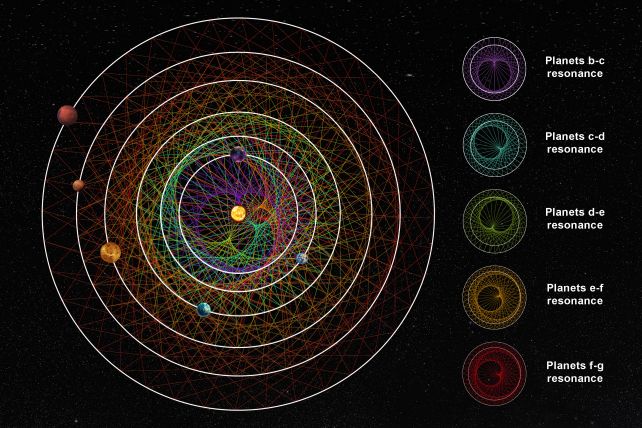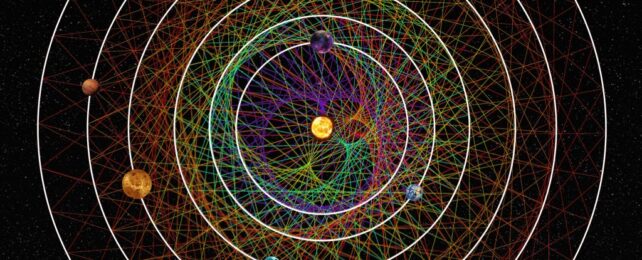A planetary system not so far from the Solar System has six worlds orbiting their star in beautiful, perfect harmony.
Each of the six exoplanets orbiting the bright star HD 110067 has an orbit in lockstep with the adjacent exoplanets, resulting in a rare phenomenon known as a chain of resonance. This suggests that the system has existed relatively undisturbed since its formation over a billion years ago – an exceptional hidden jewel in the Milky Way.
"We think only about one percent of all systems stay in resonance," says astrophysicist Rafael Luque of the University of Chicago. "It shows us the pristine configuration of a planetary system that has survived untouched."
Orbital resonances are neither uncommon, nor unexpected. They occur when two bodies orbiting a third body exert a gravitational influence on each other, in such a way that their orbital periods line up. Not exactly 1:1 – that appears to be super uncommon – but it can be expressed as a ratio.
For example, Pluto and Neptune are in resonance with each other: Pluto completes 2 orbits around the Sun for every 3 of Neptune's; that's a resonance of 2:3. And some of Jupiter's moons are in a resonance chain. For every 1 of Ganymede's orbits, Europa completes 2 and Io 4 orbits, for a chain of 1:2:4, also known as a Laplace resonance.
But six exoplanetary bodies in a resonance chain? That is something really special.
The discovery was made orbiting an orange dwarf star some 100 light-years away in the northern constellation of Coma Berenices. There, NASA's TESS exoplanet-hunting telescope spotted signs of two orbiting planets in 2020. One seemed to have a period of 5.642 days, but the orbital period of the other remained unknown.

When TESS revisited the system two years later, the data remained confusing. So Luque and his colleagues used the European Space Agency's Cheops exoplanet-studying space telescope to take a closer look. They realized that the previously derived orbital period was incorrect, and that the data showed more than just two exoplanets. In fact, they were able to resolve three – and those, they found, were in a resonance chain.
The rest fell into place after that.
"Cheops gave us this resonant configuration that allowed us to predict all the other periods," Luque says. "Without that detection from Cheops, it would have been impossible."
There are, in all, six exoplanets, ranging from 1.94 to 2.85 times the radius of Earth, a category of worlds known as mini-Neptunes. Their orbital periods are, from the innermost, 9.11 days, 13.67 days, 20.52 days, 30.79 days, 41.06 days, and 54.77 days. This means that the exoplanet pairs are in resonances of 3:2, 3:2, 3:2, 4:3, and 4:3; the innermost world in the HD 110067 system makes six orbits for every one orbit of the outermost.
This makes the system only the third known with six exoplanets in a chain of resonance.
The star is thought to have formed over a billion years ago; that its planets are in such beautiful harmony suggests that it has been unperturbed by influences such as planetary migration, a giant impact, or even a passing star. Some of the planets of the Solar System, for example, are thought to have migrated in the past.
It's really easy to disrupt resonance. Astronomers have identified a number of systems that have orbital periods that are close to resonance, but true resonance chains are few and far between. The HD 110067 system therefore is a rare treasure, and represents a wonderful opportunity to learn more about this fascinating phenomenon.
"The current delicate configuration of the planetary orbits in HD 110067 rules out any violent event over the billion-year history of the system, making it a rare 'fossil' to study migration mechanisms and the properties of its protoplanetary disk in a pristine environment," the researchers write in their paper.
"The combination of host-star brightness and the inferred presence of extended atmospheres in most of its planets makes HD 110067 the most favorable multiplanetary sub-Neptune system to be observed in transmission spectroscopy with the James Webb Space Telescope. HD 110067 offers a chance to gain insight into the nature of sub-Neptune planets and where, how and under what conditions resonant chains form and survive."
The research has been published in Nature.
